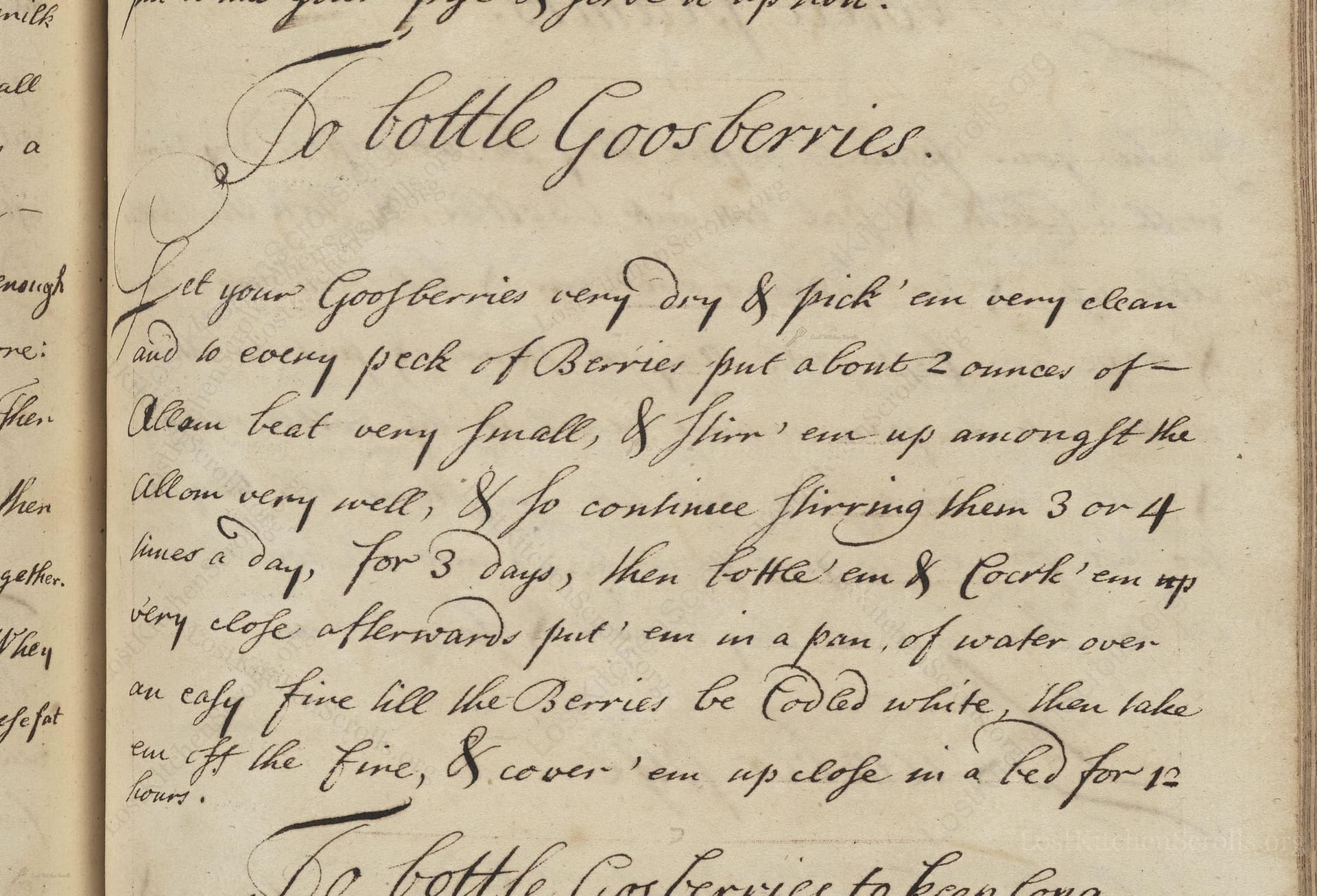To Bottle Goosberries
From the treasured pages of Various Cookeries
Unknown Author

To Bottle Goosberries
"Let your Goosberries very dry & pick 'em very clean And to every peck of Berries put about 2 ounces of Allum beat very small, & stir 'em up amongst the Allum very well, & so continue stirring them 3 or 4 times a day, for 3 days, then bottle 'em & Cork 'em up very close afterwards put 'em in a pan of water over an easy fire till the Berries be Codled white, then take 'em off the fire, & cover 'em up close in a bed for 12 hours."
Note on the Original Text
The recipe is written in the casual, direct imperatives of manuscript cookery, with spelling and punctuation reflecting the late 17th-century norms (e.g., 'Goosberries,' 'Codled white'). Culinary terms from the era—like 'codling' (to cook gently), and instructions to 'put in a bed' (insulate for slow cooling)—give insight into period kitchen methods and preservation strategies. The language assumes the reader has a working knowledge of preservation processes and available tools, making it at once straightforward and elusive for modern cooks.

Title
Various Cookeries (1690)
You can also click the book image above to peruse the original tome
Writer
Unknown
Era
1690
Publisher
Unknown
Background
A delightful glimpse into late 17th-century kitchens, this book brims with recipes, methods, and culinary wisdom passed down through generations, capturing the essence of historical gastronomy.
Kindly made available by
Folger Shakespeare Library
This recipe hails from the late 1600s, a time when food preservation was both an art and a science—before the days of canning jars and commercial pectin. Households bottled fruits like gooseberries at the height of their season, aiming to set aside the tart, fresh flavors of summer for enjoyment throughout the year. Alum was commonly used as a preservative and as a firming agent, helping the fruit maintain its texture during the long months in storage. This technique is a fascinating precursor to the water-bath canning method that emerged later.

The cook would have used a large wooden bowl for mixing the berries and alum, and repeated the stirring with a wooden spoon. Bottling was done in glass bottles, sealed with corks, often using a wooden mallet to secure the corks tightly. Heating the bottled fruit required a wide pan (usually copper or iron) large enough to accommodate several bottles, which sat in water heated slowly over a hearth fire. Heavy blankets or featherbeds were used to insulate the hot bottles after poaching, helping them to cool slowly and safely.
Prep Time
15 mins
Cook Time
1 hr
Servings
40
We've done our best to adapt this historical recipe for modern kitchens, but some details may still need refinement. We warmly welcome feedback from fellow cooks and culinary historians — your insights support the entire community!
Ingredients
- 20 lb gooseberries, trimmed and cleaned
- 2 oz alum, ground finely (food-grade alum; if unavailable, can omit as it’s not commonly used in modern preservation)
- Sterilized glass bottles with tight-fitting corks or lids
Instructions
- Begin with thoroughly cleaned and dried gooseberries—any stray stems or leaves should be removed.
- For every 20 pounds of gooseberries (approximately one peck), gently mix in 2 ounces (about 2 ounces) of finely ground alum.
- Stir the berries with the alum three or four times daily over the course of three days.
- Once this period is over, transfer the berries into sterilized glass bottles and seal them with tightly fitting corks.
- Next, place the bottles upright into a large pot or pan of cold water, ensuring the water covers at least the lower half of the bottles.
- Gradually heat the water on a low setting; you’re looking for a gentle poach rather than a boil.
- Continue until the gooseberries have turned pale or "coddled white." Remove the bottles from the water, then wrap them in thick cloth or towels (the "bed") and allow them to rest, fully covered, for 12 hours.
- This will help them finish cooking and preserve their delicate character.
Estimated Calories
60 per serving
Cooking Estimates
You’ll need about 15 minutes to trim and clean the gooseberries and mix in the alum, with brief stirring needed a few times over three days. The actual cooking in water takes about an hour, and resting them in blankets for 12 hours finalizes the process. Most effort is needed the first day; the rest is waiting.
As noted above, we have made our best effort to translate and adapt this historical recipe for modern kitchens, taking into account ingredients nowadays, cooking techniques, measurements, and so on. However, historical recipes often contain assumptions that require interpretation.
We'd love for anyone to help improve these adaptations. Community contributions are highly welcome. If you have suggestions, corrections, or cooking tips based on your experience with this recipe, please share them below.
Join the Discussion
Rate This Recipe
Dietary Preference
Main Ingredients

Den Bockfisch In Einer Fleisch Suppen Zu Kochen
This recipe hails from a German manuscript cookbook compiled in 1696, a time whe...

Die Grieß Nudlen Zumachen
This recipe comes from a rather mysterious manuscript cookbook, penned anonymous...

Ein Boudain
This recipe comes from an anonymous German-language manuscript cookbook from 169...

Ein Gesaltzen Citroni
This recipe, dating from 1696, comes from an extensive anonymous German cookbook...
Browse our complete collection of time-honored recipes



